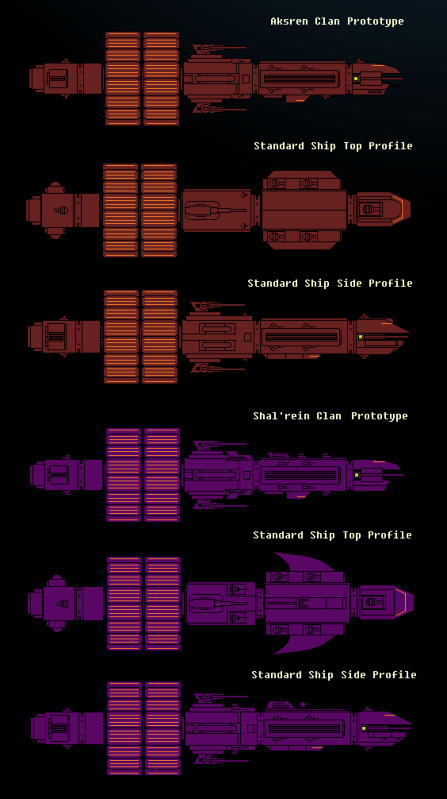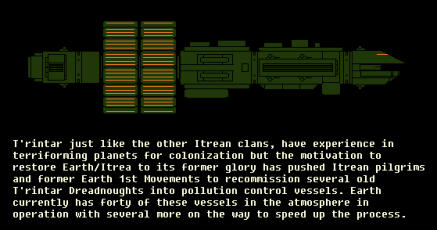
Gabatrix.net





© CMed (TheUniverseofCMed) 2021
Database and Lore

The Oldra Class Dreadnought
*Spoilers if you haven't read past Gabatrix: The First Peace arc* "The design and specifications of the Great Father class are ensuring that Itrea has a proper warship that all clans can use. I dedicate the design to the mate that I hold dearest," Greater Adjunct Gular’Shel 2298. What is often overshadowed by the venerable Ikra class, the Oldra class or “Great Father,” successfully replaced the aging heavy battleships and dreadnoughts used during the Emphra War. Its legacy is one of being present and serving the rear role of defender for the recovering Itrean clans while being one of the most powerful warships that the Itreans could muster. Design In many aspects, the Oldra class Dreadnought is simply an enlarged hull of the Ikra class Battleship. Many parts internally are shared with the ships and have very similar appearances to the different clans they served. While Gular’shel, who had earned his name as a brilliant leader during the Emphra War, had worked in conjunction with other commanders and engineers to draw up the Ikra, the Oldra was more directly tied to him. It was designed to be a more viable warship design that could replace the older heavy battleships used by the Shal’rein clan while being economically feasible and cheap to build. These warships would essentially serve as command vessels for the Ikras and provide heavier firepower at the same time. It was well-received, especially by the T’rintar and Aksren clan, as their firepower was better than their own dreadnoughts. Although, its reception into the Shal’rein clan was more muddled. Odd rumors persist that Gular’shel might have never been involved in designing the warship, but his mate, whom little was known about, was actually the one that ultimately drew it up. The creation of the first Oldra class Dreadnoughts goes as far back as the near ending of the Emphra War. By then, the Emphra were being seen less and less, and the need to relax on building influxes of new warships when the worlds were being rebuilt was paramount. At the same time, the Ikra was being introduced with the early prototypes that were even being tested over Emphra’Ka. Gular’shel had mentioned quite often that the battleships of the Itrean clans were formidable designs but often had much larger dreadnoughts that would serve as command ships. At the time of 2297, no such unified clan dreadnought had been introduced, and the greater adjunct decided to step in to take the role. While he favored the somewhat unpopular Shal’rein heavy battleships used in the Emphra War, he knew that the days of the vessel were numbered. The cost of building them was high, and trying to sell this design as the lead command ship of Ikras would be challenging. It had to be low cost. Thankfully, there were some things that did help him. For one, the Shal’rein had introduced a new heavy high-powered railgun turret that was more effective than the heavy battleship's heavy medium dual turrets. He decided to go ahead and restrict the vessels to carrying one gun on each turret to keep the costs down while still carrying the light railgun turret mounts to provide additional firepower. The criticism that the Shal’rein had was that its firepower was still pretty low for a vessel of its size. For one, it still only carries one intercept missile launcher along with the entire frame, and the CIWS batteries are too few to provide a proper counter to enemy missiles that would be launched against it. Regardless, the costs were cheap enough that supporters saw it as a benefactor in the end, and there was plenty of room for the crews to operate in, unlike the cramped conditions of the Ikra. With the Shal’rein in a deep recession, the clan began to build the Oldras with some hesitation. The Yutilian and Aksren variants, however, saw the ships as more improvements to their dreadnoughts. While the Yutilians hesitated about the railgun, it was one of the best railgun designs that they had ever seen. Plus, the ship could still hold a sizeable number of warheads in turn. This even included the ability to fire four heavy torpedo tubes in the front with enormous space to hold additional reloads. Like the Ikras, the Oldras were a profound dramatic change in how the clans looked at their most potent warships. History Sadly, the Oldras would never see combat for forty years. The prototypes were kept in the rear lines and at home. Their cost was too great at the time, and the Itreans were afraid to lose them by the time the Emphra War came to an end. It would take another couple of years before they were fully commissioned, unlike the Ikras. However, their quiet history was often reflected in the rebuilding years of the Itrean clans. Generally, they always sat at home and didn’t do anything except for simple fleet exercises. They would always lead formations of Ikras, as they were intended, or just travel alone in the fringes of Itrean solar systems. It seemed that the Oldras would almost fall into obscurity as peace had reigned. Gular’shel, himself, appraised the ship even if it never saw battle. To him, that was for the best. The Emphra never showed up again to test the Oldra’s capabilities, and there was at least enough cohesion for the clans to keep a united government. Of course, that would all change once the Itreans would fall into civil war. The destabilization and collapse of the united government would push the Oldras to be pushed up into the frontlines. Unlike the Ikras, which were in questionable operation and rear-guard duties in 2339, the Oldra dreadnoughts would serve as secondary heavy warships. Their more serious hitting firepower made them too good not to be ignored, and it didn’t require a heavy amount of crew to operate them. While their roles of command ship had been lost to the new dreadnoughts, this didn’t stop them from eventually seeing some combat. Some even viewed the Oldras as sacrificial warships where they could be easily tossed into the front while protecting the other command ships. Sadly, Zilik’s Disease would decimate the workforce on all sides. With the male population gone, the females debated on what would be done with the aging dreadnoughts. With fewer people to operate the fleets, vessels would have to be considered on what would be kept operational or not. The Ikras, which hit the chopping blocks first, then brought the debate over to the Oldras. Should they be kept operational or not? The ultimate decision was half and half. Much like the decision in 2339, the Oldras still had some value in them, but their legacy was lost as the civil wars continued. Some were decommissioned, but a few still served as rear guard duties on planets. As much as they were used in the beginning, they ultimately ended up having the same roles that they did when they were just built in the beginning. They sat at home and basically just sat there in reserve. By 2350, they remain in the perpetual orbits of their solar systems. For some, it’s one of the more boring jobs. Planetary Cleaners Ironically, a few Oldras are seeing a new lease in life for the T’rintar clan, and it’s a rather odd one. With the fact that humanity had given Earth to the clan, the Itrean people are trying to restore the planet to reasonable condition. The beleaguered state is unsuitable for human life, and even the Itreans would have a hard time living there. A cleaning and restoration campaign is in progress at the beginning of 2350. To help bolster the defenses over the planet, the T’rintar decided to pull some of the Oldras out of service to help add to the growing T’rintar defense fleet that is in position. About thirty to forty of the dreadnoughts have been retrofitted to environmental restoration vessels. There they go through the process of cleaning the oceans and the atmosphere of pollution, deadly bacteria, and diseases. Many often joked that these Oldras are doing more now than they ever did in the last fifty years. For the humans that watch them, the majestic dreadnoughts are little more than janitors sweeping the world clean, although criticism still exists that more ships need to be diverted to the cleaning efforts.
















